Home Remedies for Skin Rashes: 22 Effective Solutions
Replace those pricey lotions with some natural alternatives to gain comfort right away.
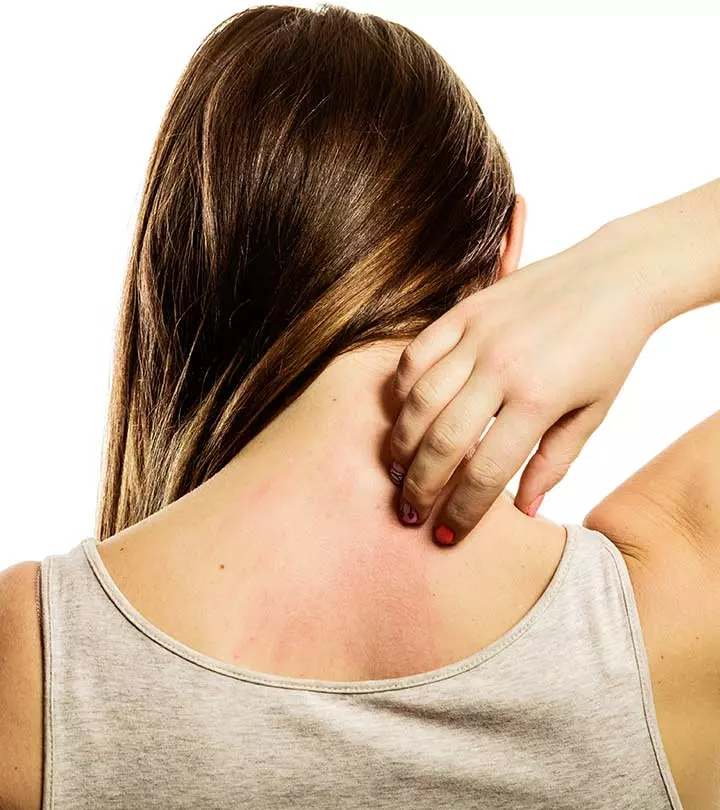
Image: Shutterstock

We all develop rashes from time to time. They are itchy, painful, distressing, and frustrating. While they go away on their own, sometimes they can be a symptom of an underlying medical condition. If you frequently develop rashes on the face, this article provides a list of some effective home remedies and tips for relief. Keep reading to explore some of the causes of skin rashes and a few simple remedies you can try to get face rash relief in a few minutes.
In This Article
What Causes Skin Rashes?
The causes of non-infectious rashes are:
- Allergies
- Reactions to medicinal drugs
- Dry skin
- Hypersensitivity to plants like poison ivy
- Autoimmune conditions
- Food allergies
Board-certified dermatologist Dr. Anna Chacon, MD, FAAD, describes a commonly observed allergic skin rash. She says, “A big, red rash may result from allergic contact dermatitis on the face. Dry, crusty skin and little red pimples may also be present.”
The causes of infectious rashes include:
- Fungal infections caused by Trichophyton, Candida, etc.
- Viral infections like herpes simplex, herpes zoster, HIV, Epstein-Barr virus (EBV)
- Infections caused by bacteria like Staphylococcus, Streptococcus, Pseudomonas, etc.
- Parasites like lice and mites
A survey conducted estimated 35.5 million inpatient visits in 2018. Out of these 35.5 million patients, 666,235 patients were diagnosed with fungal infections. It was noted that 76.3% were Aspergillus, Pneumocystis, and Candida infections. Furthermore, 6.6 million outpatient visits due to fungal infections were seen in 2018.
Rashes can be quite troublesome in the long run. Dr. Chacon adds, “It might be an allergic response, a drug reaction, or an internal reason if your rash develops blisters or if it becomes open sores. If a blistering rash appears on your skin and spreads to your lips, genitals, or the skin around your eyes, you should see a doctor.” You can follow the remedies discussed below to soothe them and accelerate healing.
Note: The remedies discussed below may help ease the symptoms of a rash. However, if the rash persists for more than a week, consult your healthcare provider to test for any underlying causes.
Key Takeaways
- Some home remedies to reduce rashes on the face are aloe vera, honey, oatmeal, cucumber, and tea tree oil.
- Cucumber has a soothing effect and may decrease swelling and tenderness.
- Tea tree oil possesses antimicrobial properties that may combat fungal and bacterial skin infections, which can cause rashes.
- Steer clear of strong chemicals and topical creams as they might make the skin worse.
- Drinking plenty of water helps to maintain skin hydration and prevents triggering factors that may cause skin irritation.
Home Remedies For Skin Rashes
- Essential Oils
- Apple Cider Vinegar
- Coconut Oil
- Baking Soda
- Aloe Vera
- Epsom Salt
- Petroleum Jelly
- Castor Oil
- Breast Milk
- Hydrogen Peroxide
- Manuka Honey
- Green Tea
- Neem Oil
- Lemon Juice
- Oatmeal
- Garlic
- Ginger
- Grapefruit Seed Extract
- Jojoba Oil
- Onion Juice
- Carrot Juice
- Humidifiers
1. Essential Oils
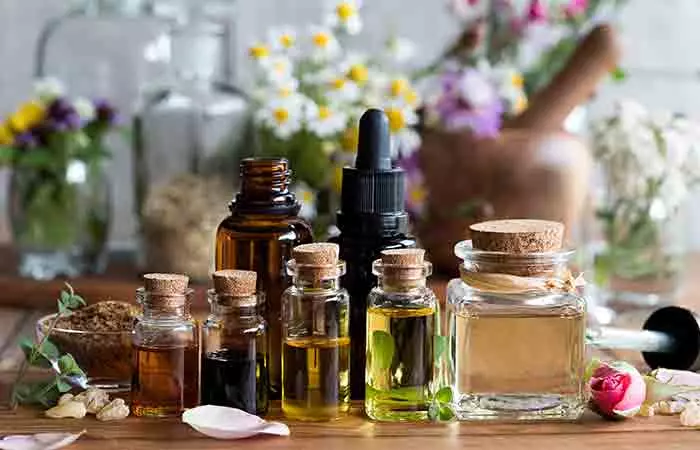
a. Tea Tree Oil
Tea tree oil possesses anti-inflammatory properties that help reduce skin inflammation and redness associated with rashes, eczema treatment, rosacea treatment, and dermatitis treatment.
It is also antiseptic and antimicrobial, which helps prevent further infections. A study published in the Clinical Microbiology Reviews journal explored the antimicrobial and medicinal properties of Melaleuca alternifolia (tea tree) oil. It examined its antiseptic and anti-inflammatory properties, detailing recent research on its mechanisms of action against bacteria, fungi, and viruses (1).
You Will Need
- 12 drops of tea tree oil
- 30 mL of any carrier oil (coconut or jojoba oil)
What You Have To Do
- Add 12 drops of tea tree oil to 30 mL of any carrier oil.
- Apply this mixture to the affected areas.
How Often You Should Do This
Do this at least once daily, preferably before going to bed.
b. Lavender Oil
Lavender oil has anti-inflammatory and analgesici The property or drug that relieves pain without numbing the nerves or altering sensory perception during medical procedures. properties (2). It can help soothe and reduce redness on the face along with swelling, pain, and inflammation associated with skin rashes.
You Will Need
- 12 drops of lavender oil
- 30 mL of coconut or olive oil
What You Have To Do
- Mix 12 drops of lavender oil with 30 ml of coconut oil.
- Apply this mixture to the affected areas.
How Often You Should Do This
Do this at least once daily.
c. Eucalyptus Oil
One of the major constituents of eucalyptus oil is eucalyptol. This compound has cooling, soothing, anti-inflammatory, and analgesic properties that can accelerate healing and provide skin allergy relief (3).
You Will Need
- 12 drops of eucalyptus oil
- 30 mL of any carrier (coconut or jojoba oil)
What You Have To Do
- Add 12 drops of eucalyptus oil to 30 mL of any carrier oil.
- Mix well and apply to the rashes.
- Leave it on overnight.
How Often You Should Do This
Do this once daily.
2. Apple Cider Vinegar
Apple cider vinegar has anti-inflammatory and antimicrobial properties (4). This may help treat skin rashes and ease the symptoms. However, more scientific studies are needed to prove this effect.
You Will Need
- 1 tablespoon of apple cider vinegar
- ½ cup of water
- Cotton pads
What You Have To Do
- Add a tablespoon of apple cider vinegar to half a cup of water.
- Soak a cotton pad in this mixture and apply it to the rashes.
- Allow the mixture to be absorbed completely.
How Often You Should Do This
Do this 2 times daily.
Zoe, a beauty and lifestyle blogger, tried using apple cider vinegar as a toner to treat facial rashes. She writes, “I recommend that if you are looking for a way to clear it up then this is a good start (i).”
3. Coconut Oil
Coconut oil is proven to exhibit strong anti-inflammatory, analgesic, and antimicrobial activities
(5), (6). These activities can soothe the existing rashes and prevent their recurrence. It is a great acne rash removal remedy.
You Will Need
Coconut oil (as required)
What You Have To Do
- Take a little coconut oil in your palm and apply it gently to the affected areas.
- Leave it on for 30 to 60 minutes before washing it off.
- You can also leave it on overnight.
How Often You Should Do This
Do this once daily.
4. Baking Soda
Baking soda neutralizes the pH of your skin. It also has an antipruritic effect on rashes (7). However, there is insufficient scientific evidence to prove the effect of baking soda in treating skin rashes.
You Will Need
- 1 teaspoon of baking soda
- Water (as required)
What You Have To Do
- Mix the baking soda with water to make a thick paste.
- Apply this mixture to the rashes and allow it to dry.
- Wash the baking soda mixture off your skin with plain water.
Caution:
Do a patch test before using baking soda on your skin.
How Often You Should Do This
Do this once daily.
5. Aloe Vera
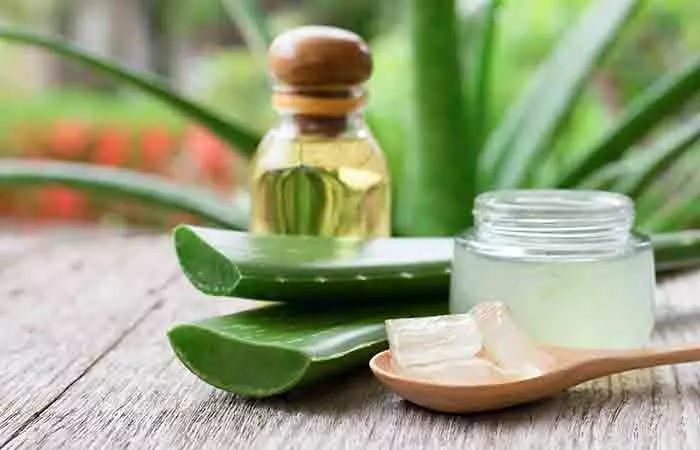
You can use aloe vera for rashes on the skin, as it is an effective remedy due to its healing and anti-inflammatory properties. It provides a soothing sensation that calms the skin. An animal study published in the Journal of Ethnopharmacology investigated the anti-inflammatory properties of aloe vera gel extracts. Researchers used aqueous, chloroform, and ethanol aloe gel extracts. Results showed that aqueous and chloroform extracts significantly reduced paw edema and neutrophil migration, while the ethanol extract primarily reduced neutrophil migration. Chemical analysis identified various bioactive compounds, including anthraquinones, sterols, and glycosides that may contribute to aloe vera’s anti-inflammatory effects (8). This gel is also antimicrobial, which helps prevent the recurrence of the infection.
You Will Need
Aloe gel (as required)
What You Have To Do
- Scrape a little fresh aloe gel from the aloe plant.
- Apply it directly to the rashes on your face and skin.
- Leave it on for at least 30 minutes before washing off.
How Often You Should Do This
Do this 1 to 2 times daily.
6. Epsom Salt
Epsom salt (magnesium sulfate) has anti-inflammatory properties (9). Hence, it can be used for treating the inflammation, swelling, and itchiness associated with skin rashes.
You Will Need
- 1 cup of Epsom salt
- Water
What You Have To Do
- Add a cup of Epsom salt to a tub of water.
- Soak in the Epsom salt bath for 20 to 30 minutes.
How Often You Should Do This
Do this once daily or every alternate day.
7. Petroleum Jelly
Petroleum jelly forms a protective layer on your skin, enhancing your natural skin barrier, and prevents microbial infections while keeping your skin well moisturized. In one study, Vaseline, along with other antibiotics and antihistaminesi A class of drugs that blocks histamine, a substance the body releases during infection, to relieve allergy symptoms. , was shown to improve facial rash in one week of continued use (10). In such cases, the timing of facial rash diagnosis is also crucial.
You Will Need
Petroleum jelly (as required)
What You Have To Do
- Apply a little petroleum jelly gently to the affected area.
- Leave it on and reapply as and when required.
How Often You Should Do This
Do this multiple times daily, as per your requirement.
Note: Petroleum jelly can also be used to treat diaper rashes in babies.
8. Castor Oil
The presence of ricinoleic acid in castor oil gives it anti-inflammatory properties that can help reduce inflammation, swelling, and itchiness (11). It is commonly used to treat many skin disorders (12).
You Will Need
2 teaspoons of castor oil
What You Have To Do
- Apply a little castor oil to the affected areas.
- Leave it on for at least 30 minutes before washing it off.
How Often You Should Do This
Do this once daily.
Caution: Do a patch test before following this remedy as some individuals could be sensitive to castor oil.
9. Breast Milk
Breast milk moisturizes your baby’s skin and protects it from further infections. It can also help treat other skin problems (13).
You Will Need
A few drops of breast milk
What You Have To Do
- Apply a few drops of breast milk to the rashes on your baby’s skin.
- Allow it to dry and reapply as required.
How Often You Should Do This
Do this 1 to 2 times daily.
10. Hydrogen Peroxide
Hydrogen peroxide has antibacterial properties (14). Hence, it may help in treating infectious rashes and prevent further infections. However, there is insufficient evidence to prove this effect.
You Will Need
- 3% hydrogen peroxide
- Cotton balls
What You Have To Do
- Dip a cotton ball in hydrogen peroxide and apply it directly to the rashes.
- Allow it to dry and wash it off with water.
How Often You Should Do This
Do this 1 to 2 times daily.
Caution: Do not try this remedy if you have sensitive skin.
11. Manuka Honey
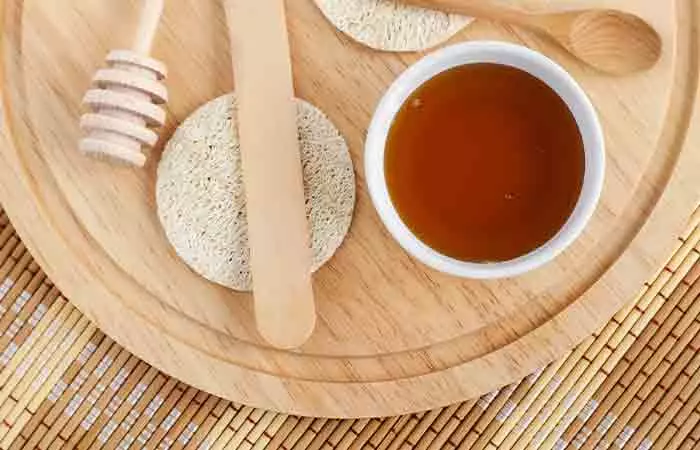
Manuka honey is quite popular for its powerful anti-inflammatory and healing properties, and it helps reduce swelling and inflammation. A study published in the Evidence-Based Complementary and Alternative Medicine journal explored the healing effects of manuka honey on acetic acid-induced chronic gastric ulcers in rats. Researchers found that manuka honey significantly reduced ulcer severity, preserved mucosal glycoproteins, and lowered inflammation. It also enhanced antioxidant defenses while boosting the anti-inflammatory cytokine IL-10 (15).
You Will Need
- 1 tablespoon of manuka honey
- 2 teaspoons of olive oil
What You Have To Do
- Mix a tablespoon of manuka honey with two teaspoons of olive oil.
- Apply the mixture to the affected areas.
- Leave it on for 30 to 60 minutes before washing it off.
How Often You Should Do This
Do this at least once daily.
12. Green Tea
Green tea contains beneficial polyphenolsi A naturally occurring plant micronutrient that can benefit your skin because of its antioxidant and anti-inflammatory properties. that protect your skin from free radical damage due to their antioxidant and anti-inflammatory properties (16),(17). This helps soothe the rash and prevent its recurrence.
You Will Need
- 1 teaspoon of green tea
- 1 cup of hot water
- Cotton pads
What You Have To Do
- Add a teaspoon of green tea to a cup of hot water.
- Allow it to steep for 5 to 10 minutes.
- Keep it aside to cool.
- Dip a cotton pad into the tea and apply it to the affected areas.
- Leave it on for at least 30 minutes before washing it off.
How Often You Should Do This
Do this once daily.
13. Neem Oil
Neem oil
exhibits anti-inflammatory, antiseptic, and antihistamine activities, which treat skin rashes and their symptoms like inflammation and redness (18), (19).
You Will Need
A few drops of neem oil
What You Have To Do
- Apply neem oil directly to the rashes on your body and face.
- Leave it on overnight or for at least 30 minutes before washing it off.
How Often You Should Do This
Do this once daily.
14. Lemon Juice
Lemon juice is rich in vitamin C, a powerful antioxidant. Lemons also have anti-inflammatory and bactericidal properties (20), (21). All of these help in combating skin rashes and preventing further infections.
You Will Need
- ½ lemon
- Cotton pads
What You Have To Do
- Squeeze the juice from half a lemon into a small bowl.
- Dip a cotton pad into this juice and apply it to the affected areas.
- If you have sensitive skin, dilute the lemon juice with an equal amount of water.
- Leave it on for 20 to 30 minutes before washing it off.
How Often You Should Do This
Do this once daily or every alternate day.
Caution: Do not use this remedy if you have dry or sensitive skin.
15. Oatmeal
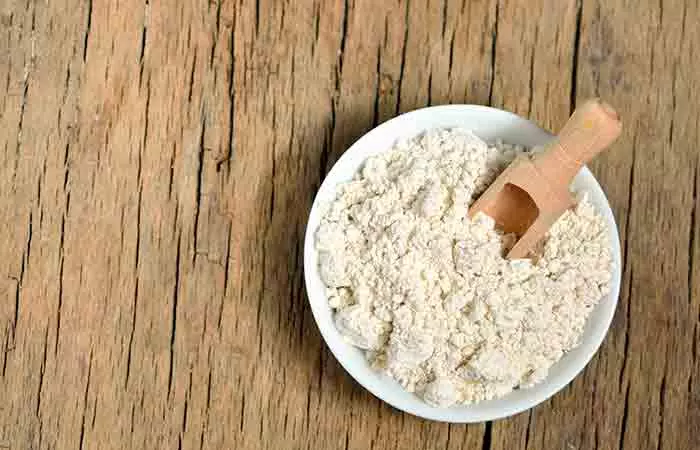
Oatmeal has antioxidant and anti-inflammatory properties that can help in treating different skin conditions, like eczema, pruritusi The scientific term used to describe the itching feeling or sensation that makes you want to scratch the skin. , atopic dermatitis, acneiform eruptionsi A group of skin disorders characterized by red bumps and pus-filled bumps on the skin, resembling acne. , and viral infections (22), (23). This effective home remedy reduces skin itchiness, dryness, and roughness associated with rashes.
You Will Need
- 1 cup of oatmeal
- Water
What You Have To Do
- Grind the oatmeal in a blender finely.
- Mix the powder into your bathtub.
- Soak in this solution for 30 minutes and rinse off with warm water.
How Often You Should Do This
Do this 3 times a week.
16. Garlic
Garlic contains a compound called allicin that possesses excellent anti-inflammatory and antimicrobial properties (24),(25).
You Will Need
Minced garlic cloves
What You Have To Do
- Mince a few garlic cloves.
- Apply the minced garlic to the affected areas.
- Leave it on for 20 to 30 minutes and wash it off with water.
How Often You Should Do This
Do this once daily.
Caution: Do a patch test before using this remedy, as garlic can burn your skin.
17. Ginger
Ginger contains gingerol, which is a potent analgesic, anti-inflammatory, and antimicrobial compound (26), (27). It can help ease the irritation and inflammation associated with skin rashes.
You Will Need
- 1-2 inches of ginger
- 1 cup of hot water
- Cotton pads
What You Have To Do
- Add an inch or two of ginger to a glass of steaming hot water.
- Steep for 5 to 10 minutes.
- Once the ginger solution cools down, soak a cotton pad in it and apply it to the affected areas.
- Wash off after 30 minutes or so.
How Often You Should Do This
Do this 1 to 2 times daily.
18. Grapefruit Seed Extract
The grapefruit seed extract is loaded with bioflavonoids that possess antimicrobial and anti-inflammatory properties (28). It also aids wound healing (29).
You Will Need
Grapefruit seed extract (as required)
What You Have To Do
- Apply a few drops of grapeseed fruit extract directly to the rashes with your finger.
- Allow it to be completely absorbed by the skin before washing it off.
How Often You Should Do This
Do this 1 to 2 times daily.
19. Jojoba Oil
Jojoba oil is rich in vitamin E and can be quickly absorbed by the skin. It helps in keeping the skin well moisturized and also combats rashes due to its antimicrobial and anti-inflammatory properties (30).
You Will Need
Jojoba oil (as required)
What You Have To Do
- Apply a few drops of jojoba oil to your skin.
- Leave it on overnight and wash off the next morning.
How Often You Should Do This
Do this once daily.
Caution: Do a patch test with jojoba oil before applying it to your rashes.
20. Onion Juice
The presence of quercetin in onions makes them one of the best remedies for skin rashes. Quercetin has anti-inflammatory and antiseptic properties and can help in disinfecting the rash and healing it (31).
You Will Need
- 1 onion
- Cotton balls
What You Have To Do
- Extract the juice from an onion.
- Dip a cotton ball in this and apply it to the affected areas.
- If you have sensitive skin, mix olive oil with the onion juice.
- Leave it on for 30 minutes and wash off.
- Additionally, you can also include onion juice in your diet.
How Often You Should Do This
Do this 1 to 2 times daily.
Caution: Some individuals may be allergic to onions. Please do a patch test.
21. Carrot Juice

Carrot juice contains high levels of vitamin A, which boosts skin health. Deficiencies in vitamin A can trigger skin allergies (32). Thus, consumption of carrot juice daily can help treat skin problems, like rashes.
You Will Need
1 glass of carrot juice
What You Have To Do
Consume a glass of carrot juice.
How Often You Should Do This
Do this daily.
22. Humidifiers
During winter months or in air-conditioned rooms, dry air may harm the skin barrier function and make it more prone to irritation and damage from allergens (33). It may also worsen existing dermatological conditions. Using a humidifier may help add moisture to the air and calm your skin. You can either buy a store-bought humidifier or prepare one at home using some simple objects.
You Will Need
- A big piece of sponge
- A plastic container with a lid
- Water
What You Have To Do
- Cut the sponge so it fits inside the plastic container.
- Place it inside the container and pour water over it until it is completely soaked.
- Cover the container with the lid, leaving a small gap to allow moisture to escape.
How Often You Should Do This
Do this daily.
 Quick Tip
Quick TipPaying a little more attention to your diet along with following the above remedies can help you treat skin rashes.
Diet For Rashes
Best Foods To Reduce Rashes
Foods that can help in reducing rashes include:
- Beans
- Chickpeas
- Carrots
- Sweet potatoes
- Mangoes
- Vitamin C-rich foods like citrus fruits, spinach, broccoli.
- Fatty fish
Foods To Avoid
Foods that need to be avoided are:
- Eggs
- Milk
- Peanuts
- Tree nuts
- Wheat
- Soy
- Shellfish
These foods account for about 90% of all food allergies and are best avoided.
While a proper diet may help alleviate rashes, it is important to know when to seek medical attention. If the condition worsens or doesn’t improve with dietary changes, you may need to get professional help. Scroll down to know more.
When To Seek Medical Attention
If your rashes frequently occur or remain even after using these home remedies and other OTC treatments, you should consult a physician for a proper diagnosis. It is important to get medical help right away if you have face rashes combined with additional symptoms such as breathing difficulties, swelling, extreme discomfort, or if the rash spreads quickly. These signs may lead to a severe allergic reaction or other underlying medical conditions that need to be treated right once. In addition, you should consult a doctor if the rash seems contagious (as indicated by pus or growing redness), or if it is accompanied by a fever or other concerning symptoms.
Given below are some additional tips to prevent developing skin rashes.
Prevention Tips
- Avoid using harsh or irritating soaps.
- Avoid contact with those who have infectious rashes.
- Exercise regularly.
- Keep your stress under control.
- Avoid wearing tight clothes. Instead, wear light and loose-fitting clothes.
- Maintain personal hygiene.
- Consider patch-testing new skin care products to check for adverse reactions.
Dr. Chacon advises, “Without a prescription, hydrocortisone cream (1% concentration) can treat many rashes. A prescription is required to purchase stronger cortisone creams. Apply moisturizers to eczema-affected skin. To treat eczema or psoriasis symptoms, use oatmeal bath products, which are sold in pharmacies.”
 Quick Tip
Quick TipLet’s now look at the type of skin rashes and their signs and symptoms.
Types Of Skin Rashes
Any abnormal change in the color or texture of your skin often indicates a skin rash. Rashes are mainly classified into two types – noninfectious and infectious rashes.
Non-infectious rashes include eczema, contact dermatitis, psoriasis, seborrheic dermatitisi A common chronic skin condition that affects the oily areas of the body, causing dandruff, scaly patches, and inflamed skin. , rosaceai A chronic inflammatory skin condition that causes red, swollen, and small pus-filled bumps on the skin and facial redness. , hives, xerosis (dry skin), and allergic dermatitis.
Infectious rashes are ringworm, impetigo, scabiesi An itchy skin rash caused by tiny mites called Sarcoptes scabiei that can burrow into the skin. , herpes, chickenpox, and shingles.
Signs and Symptoms Of Skin Rashes
- Itchy red skin
- Bumpy skin, with pus-filled bumps
- Blisters
- Scaly, dry skin
These symptoms could surface individually or in combination, depending on the cause of your rash.
Infographic: Top Natural Ways To Get Rid Of Skin Rashes
You have certainly had a rash at some point in your life but do you know how to get rid of it? It depends on factors like the kind of rash and how quickly the swelling can be controlled. While some might disappear, others might stick around for a while. We have rounded up a few natural remedies that can quickly get rid of these rashes in the infographic below!
Some thing wrong with infographic shortcode. please verify shortcode syntax
Rashes on the face are quite commonplace and may either be infectious or non-infectious. Some causes of rashes include allergies, autoimmune conditions, reactions to certain medications, parasites, and fungal, viral, or bacterial infections. Regardless of the cause, rashes can be uncomfortable and difficult to deal with, especially when they appear on the face. Home remedies to get rid of rashes on the face include the use of essential oils and natural oils, breast milk, aloe vera, baking soda, onion juice, oatmeal, carrot juice, manuka honey, petroleum jelly, and green tea, to name a few. If the rashes persist, consult your healthcare provider so that the underlying cause can be diagnosed and treated. Now you know all about face rash remedies. Hope you have an itch-free life, and don’t miss out on sun protection for extra care!
Frequently Asked Questions
How long do skin rashes take to heal?
Skin rashes can take anywhere between 2 to 4 weeks to disappear completely. However, treatment can speed up your recovery.
Can stress cause a rash on my face?
Yes, stress can lead to red and raised rashes called hives on different parts of the body, such as the neck, face, hands, and chest. Stress can also aggravate existing skin conditions such as eczema and psoriasis (34).
How to get rid of a rash overnight?
It is not possible to get rid of a rash overnight. However, if the rash is caused by a medical condition or allergic reaction, medication might help fix it quicker than home remedies.
Is it safe to use makeup or skincare products when you have a facial rash?
No, it is generally not recommended to use makeup or skincare products when you have a facial rash, as they may aggravate the condition.
How does age affect the development and treatment of facial rashes?
Certain types of rashes are more common in infants and young children while others affect middle-aged or older adults. The skin’s ability to repair itself and fight infection may also decrease with age, making it harder to treat certain rashes. That is why treatment should be adjusted based on age and overall health to ensure it is effective and safe.
Can environmental factors like pollution or weather cause facial rashes?
Yes, pollution and weather can irritate the skin and cause inflammation, which can result in a rash. Extreme heat, cold, or wind can also cause dryness or irritation, increasing the risk of developing rashes.
Is it possible to get rid of facial rashes permanently?
This depends on the underlying cause of the rash. Some people may have long periods of remission from particular types of rashes, while others may have periodic flare-ups.
Illustration: Home Remedies To Get Rid Of Rashes On The Face + Diet And Prevention Tips
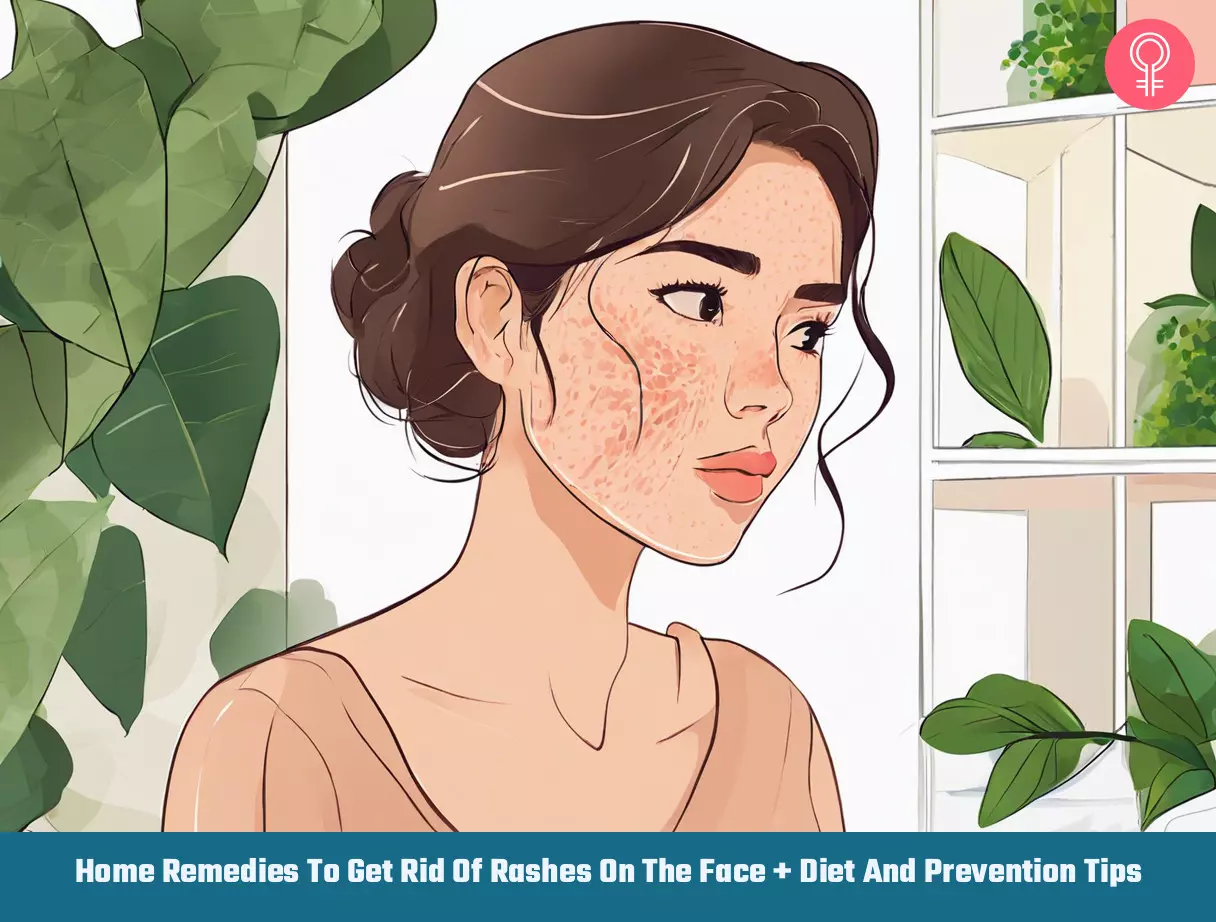
Image: Stable Diffusion/StyleCraze Design Team
Looking for valuable insights on effectively managing a face rash? Check out the following video to discover practical tips and techniques to minimize redness and irritation and take care of face rashes.
Personal Experience: Source
StyleCraze's articles are interwoven with authentic personal narratives that provide depth and resonance to our content. Below are the sources of the personal accounts referenced in this article.
i. Treating perioral dermatitishttps://www.beautifinous.co.uk/2014/12/treating-perioral-dermatitis.html
References
Articles on StyleCraze are backed by verified information from peer-reviewed and academic research papers, reputed organizations, research institutions, and medical associations to ensure accuracy and relevance. Read our editorial policy to learn more.
- Carson, C. F., K. A. Hammer, and T. V. Riley. “Melaleuca alternifolia (tea tree) oil: a review of antimicrobial and other medicinal properties.” Clinical microbiology reviews 19.1 (2006): 50-62.
https://pubmed.ncbi.nlm.nih.gov/16418522// - SILVA, GABRIELA L., et al. “Antioxidant, analgesic and anti-inflammatory effects of lavender essential oil.” Anais da Academia Brasileira de Ciências 87.2 (2015): 1397-1408.
https://pubmed.ncbi.nlm.nih.gov/26247152// - Silva, Jeane, et al. “Analgesic and anti-inflammatory effects of essential oils of Eucalyptus.” Journal of ethnopharmacology 89.2-3 (2003): 277-283.
https://pubmed.ncbi.nlm.nih.gov/14611892// - Yagnik, Darshna, Vlad Serafin, and Ajit J. Shah. “Antimicrobial activity of apple cider vinegar against Escherichia coli, Staphylococcus aureus and Candida albicans; downregulating cytokine and microbial protein expression.” Scientific reports 8.1 (2018): 1-12.
https://www.ncbi.nlm.nih.gov/pmc/articles/PMC5788933/ - Intahphuak, S., P. Khonsung, and A. Panthong. “Anti-inflammatory, analgesic, and antipyretic activities of virgin coconut oil.” Pharmaceutical biology 48.2 (2010): 151-157.
https://pubmed.ncbi.nlm.nih.gov/20645831// - Shilling, Michael, et al. “Antimicrobial effects of virgin coconut oil and its medium-chain fatty acids on Clostridium difficile.” Journal of medicinal food 16.12 (2013): 1079-1085.
https://pubmed.ncbi.nlm.nih.gov/24328700// - Wolf, Ronni, and Anatol Krakowski. “Variations in aquagenic pruritus and treatment alternatives.” Journal of the American Academy of Dermatology 18.5 (1988): 1081-1083.
https://pubmed.ncbi.nlm.nih.gov/2838535// - Vázquez, Beatriz, et al. “Antiinflammatory activity of extracts from Aloe vera gel.” Journal of ethnopharmacology 55.1 (1996): 69-75.
https://pubmed.ncbi.nlm.nih.gov/9121170// - Rudolf, R. D. “The use of Epsom salts, historically considered.” Canadian Medical Association journal 7.12 (1917): 1069.
https://www.ncbi.nlm.nih.gov/pmc/articles/PMC1584988/ - Waris, Waris, et al. “Severe cutaneous reaction to cetuximab with possible association with the use of over-the-counter skin care products in a patient with oropharyngeal cancer.” Cutaneous and ocular toxicology 28.1 (2009): 41-44.
https://pubmed.ncbi.nlm.nih.gov/19514925// - Vieira, C et al. “Pro- and anti-inflammatory actions of ricinoleic acid: similarities and differences with capsaicin.” Naunyn-Schmiedeberg’s archives of pharmacology vol. 364,2 (2001): 87-95.
https://pubmed.ncbi.nlm.nih.gov/11534859/ - “Final report on the safety assessment of Ricinus Communis (Castor) Seed Oil, Hydrogenated Castor Oil, Glyceryl Ricinoleate, Glyceryl Ricinoleate SE, Ricinoleic Acid, Potassium Ricinoleate, Sodium Ricinoleate, Zinc Ricinoleate, Cetyl Ricinoleate, Ethyl Ricinoleate, Glycol Ricinoleate, Isopropyl Ricinoleate, Methyl Ricinoleate, and Octyldodecyl Ricinoleate.” International journal of toxicology vol. 26 Suppl 3 (2007): 31-77.
https://pubmed.ncbi.nlm.nih.gov/18080873// - Witkowska-Zimny, Malgorzata et al. “Milk Therapy: Unexpected Uses for Human Breast Milk.” Nutrients vol. 11,5 944.
https://www.ncbi.nlm.nih.gov/pmc/articles/PMC6567207/ - Thomas, E L et al. “Antibacterial activity of hydrogen peroxide and the lactoperoxidase-hydrogen peroxide-thiocyanate system against oral streptococci.” Infection and immunity vol. 62,2 (1994): 529-35.
https://www.ncbi.nlm.nih.gov/pmc/articles/PMC186138/ - Almasaudi, Saad B et al. “Manuka Honey Exerts Antioxidant and Anti-Inflammatory Activities That Promote Healing of Acetic Acid-Induced Gastric Ulcer in Rats.” Evidence-based complementary and alternative medicine : eCAM vol. 2017 (2017): 5413917.
https://www.ncbi.nlm.nih.gov/pmc/articles/PMC5307292/ - OyetakinWhite, Patricia et al. “Protective mechanisms of green tea polyphenols in skin.” Oxidative medicine and cellular longevity vol. 2012 (2012): 560682.
https://www.ncbi.nlm.nih.gov/pmc/articles/PMC3390139/ - Kim, Hyun Kyu et al. “Human skin safety test of green tea cell extracts in condition of allergic contact dermatitis.” Toxicological research vol. 28,2 (2012): 113-6.
https://www.ncbi.nlm.nih.gov/pmc/articles/PMC3834413/ - Schumacher, Marc et al. “Anti-inflammatory, pro-apoptotic, and anti-proliferative effects of a methanolic neem (Azadirachta indica) leaf extract are mediated via modulation of the nuclear factor-κB pathway.” Genes & nutrition vol. 6,2 (2011): 149-60.
https://www.ncbi.nlm.nih.gov/pmc/articles/PMC3092905/ - Alzohairy, Mohammad A. “Therapeutics Role of Azadirachta indica (Neem) and Their Active Constituents in Diseases Prevention and Treatment.” Evidence-based complementary and alternative medicine : eCAM vol. 2016 (2016): 7382506.
https://www.ncbi.nlm.nih.gov/pmc/articles/PMC4791507/ - Galati, Enza Maria et al. “Anti-inflammatory effect of lemon mucilage: in vivo and in vitro studies.” Immunopharmacology and immunotoxicology vol. 27,4 (2005): 661-70.
https://pubmed.ncbi.nlm.nih.gov/16435583// - de Castillo, M C et al. “Bactericidal activity of lemon juice and lemon derivatives against Vibrio cholerae.” Biological & pharmaceutical bulletin vol. 23,10 (2000): 1235-8.
https://pubmed.ncbi.nlm.nih.gov/11041258// - Reynertson, Kurt A et al. “Anti-inflammatory activities of colloidal oatmeal (Avena sativa) contribute to the effectiveness of oats in treatment of itch associated with dry, irritated skin.” Journal of drugs in dermatology : JDD vol. 14,1 (2015): 43-8.
https://pubmed.ncbi.nlm.nih.gov/25607907/ - Pazyar, Nader et al. “Oatmeal in dermatology: a brief review.” Indian journal of dermatology, venereology and leprology vol. 78,2 (2012): 142-5.
https://pubmed.ncbi.nlm.nih.gov/22421643// - Arreola, Rodrigo et al. “Immunomodulation and anti-inflammatory effects of garlic compounds.” Journal of immunology research vol. 2015 (2015): 401630.
https://pubmed.ncbi.nlm.nih.gov/25961060/ - Ankri, S, and D Mirelman. “Antimicrobial properties of allicin from garlic.” Microbes and infection vol. 1,2 (1999): 125-9.
https://pubmed.ncbi.nlm.nih.gov/10594976/ - Young, Haw-Yaw et al. “Analgesic and anti-inflammatory activities of [6]-gingerol.” Journal of ethnopharmacology vol. 96,1-2 (2005): 207-10.
https://pubmed.ncbi.nlm.nih.gov/15588672// - Park, Miri et al. “Antibacterial activity of [10]-gingerol and [12]-gingerol isolated from ginger rhizome against periodontal bacteria.” Phytotherapy research : PTR vol. 22,11 (2008): 1446-9.
https://pubmed.ncbi.nlm.nih.gov/18814211// - Heggers, John P et al. “The effectiveness of processed grapefruit-seed extract as an antibacterial agent: II. Mechanism of action and in vitro toxicity.” Journal of alternative and complementary medicine (New York, N.Y.) vol. 8,3 (2002): 333-40.
https://pubmed.ncbi.nlm.nih.gov/12165191// - Hemmati, Ali Asghar et al. “The topical effect of grape seed extract 2% cream on surgery wound healing.” Global journal of health science vol. 7,3 52-8. 29.
https://pubmed.ncbi.nlm.nih.gov/25948437// - Pazyar, N et al. “Jojoba in dermatology: a succinct review.” Giornale italiano di dermatologia e venereologia : organo ufficiale, Societa italiana di dermatologia e sifilografia vol. 148,6 (2013): 687-91.
https://pubmed.ncbi.nlm.nih.gov/24442052/ - Shaik, Y B et al. “Role of quercetin (a natural herbal compound) in allergy and inflammation.” Journal of biological regulators and homeostatic agents vol. 20,3-4 (2006): 47-52.
https://pubmed.ncbi.nlm.nih.gov/18187018/ - Rollman, O, and A Vahlquist. “Vitamin A in skin and serum–studies of acne vulgaris, atopic dermatitis, ichthyosis vulgaris and lichen planus.” The British journal of dermatology vol. 113,4 (1985): 405-13.
https://pubmed.ncbi.nlm.nih.gov/2933053// - Engebretsen, K A. “The effect of environmental humidity and temperature on skin barrier function and dermatitis.” J Eur Acad Dermatol Venereol . 2016 Feb;30(2):223-49.
https://pubmed.ncbi.nlm.nih.gov/26449379/ - Ghada A. Bin Saif et al. “Association of psychological stress with skin symptoms among medical students.” Saudi Medical Journal, vol 39(1); 2018 Jan.
https://www.ncbi.nlm.nih.gov/pmc/articles/PMC5885122/
Read full bio of Dr. Jyoti Gupta
- Dr. Anna Chacon, MD, FAAD, is a double board-certified dermatologist with over 7 years of experience. She has authored many peer-reviewed articles and managed clinical research studies during her fellowship. She completed her medical school in the PLME (Program of Liberal Medical Education) at Brown University.
 Dr. Anna Chacon, MD, FAAD, is a double board-certified dermatologist with over 7 years of experience. She has authored many peer-reviewed articles and managed clinical research studies during her fellowship. She completed her medical school in the PLME (Program of Liberal Medical Education) at Brown University.
Dr. Anna Chacon, MD, FAAD, is a double board-certified dermatologist with over 7 years of experience. She has authored many peer-reviewed articles and managed clinical research studies during her fellowship. She completed her medical school in the PLME (Program of Liberal Medical Education) at Brown University.
Read full bio of Shaheen Naser
Read full bio of Anjali Sayee
Read full bio of Swathi E







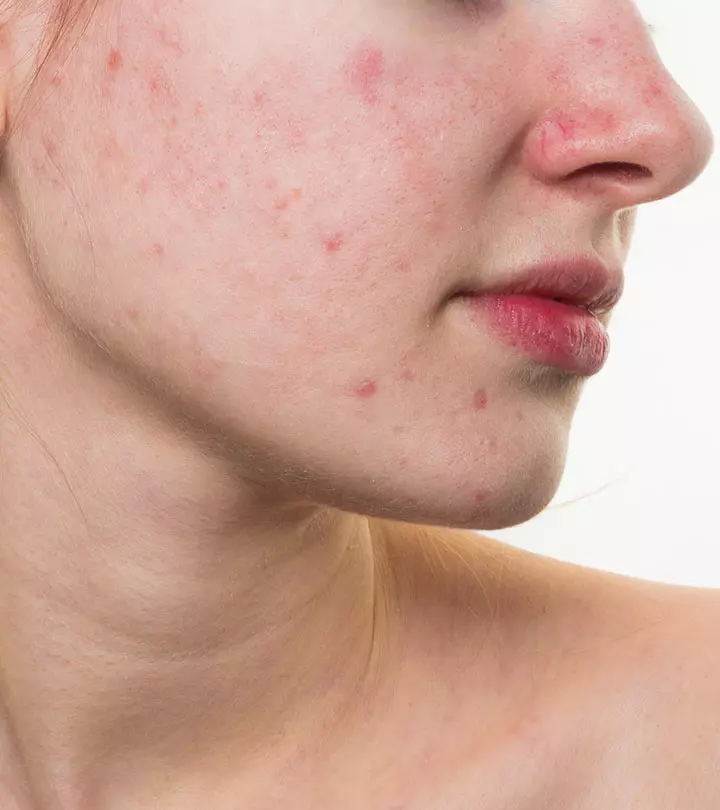
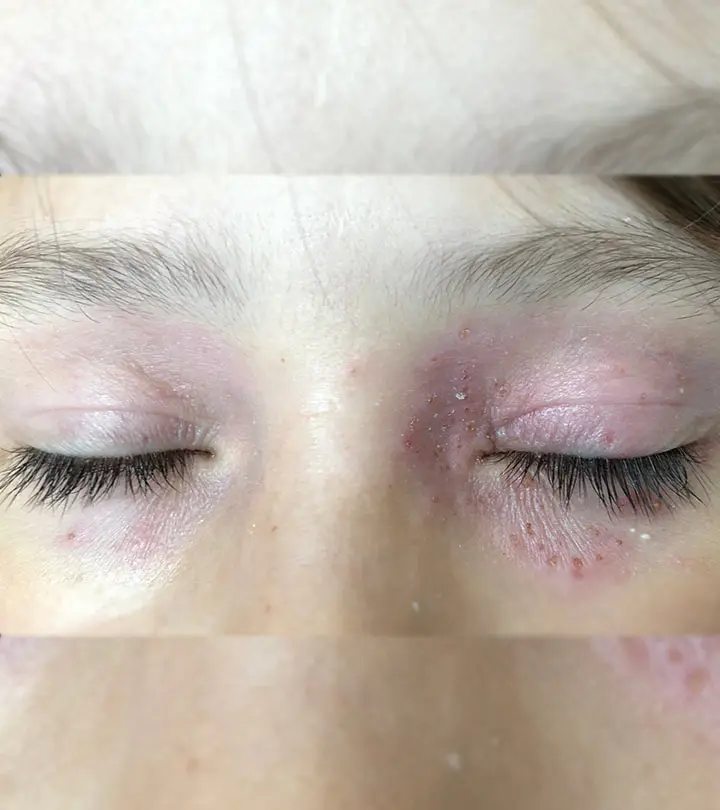
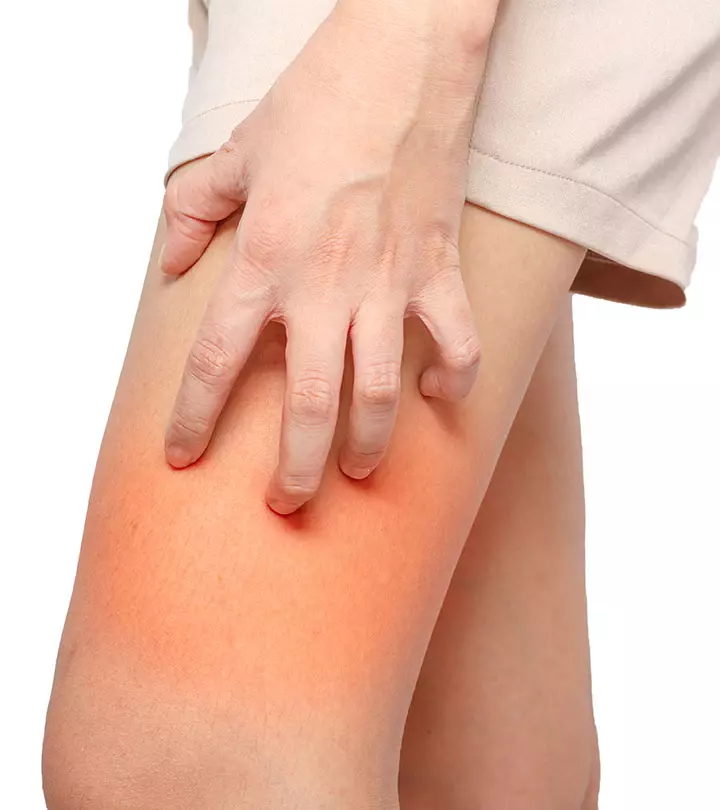
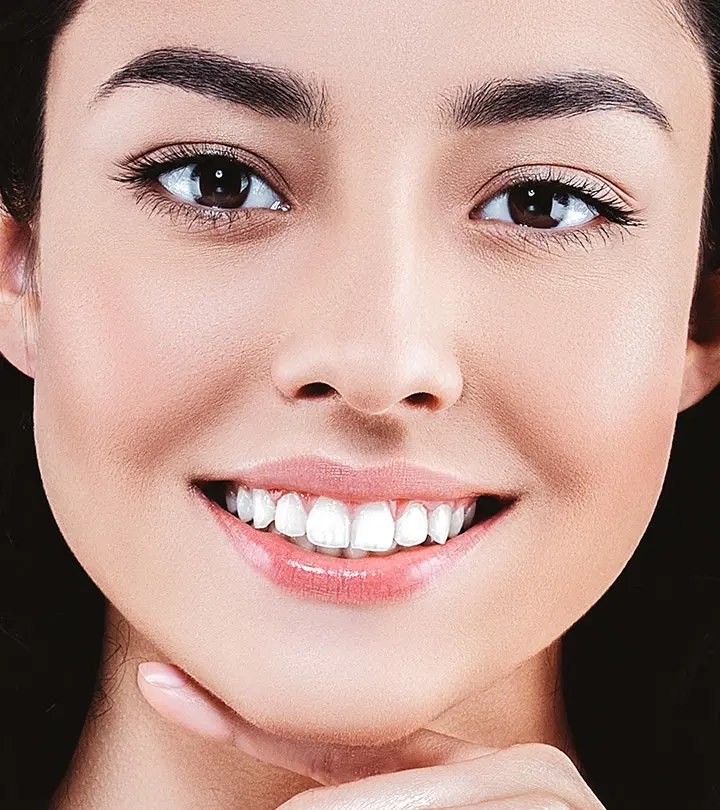
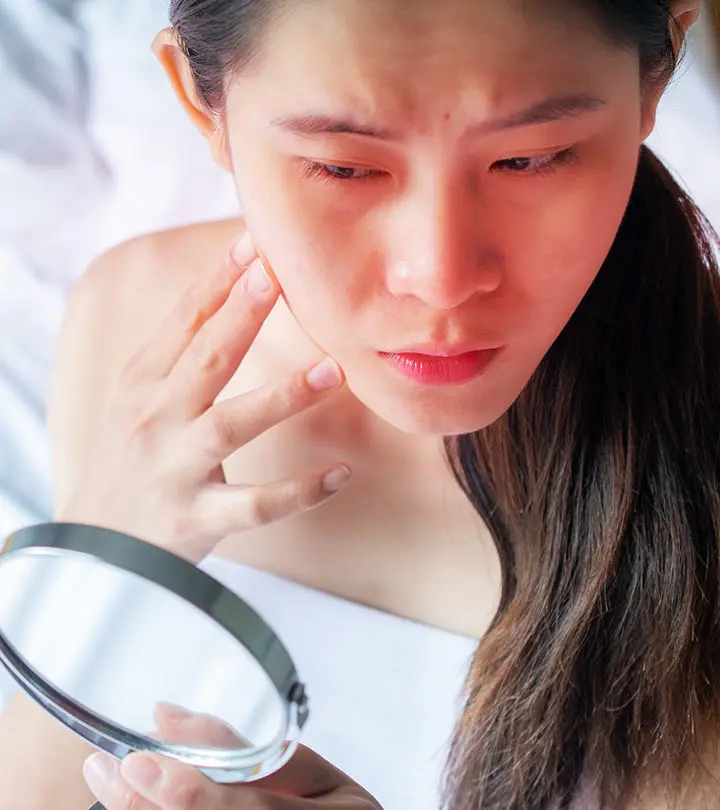

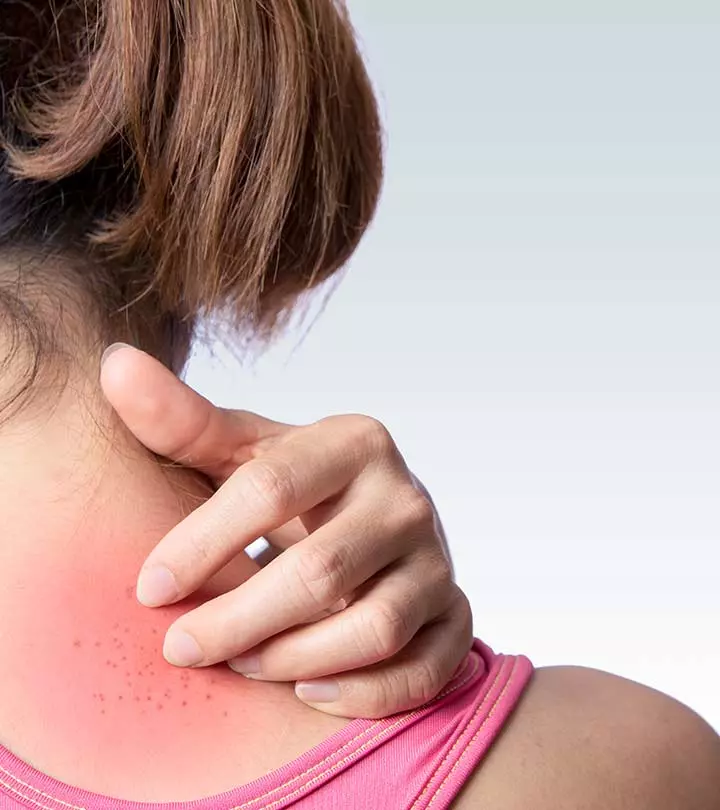
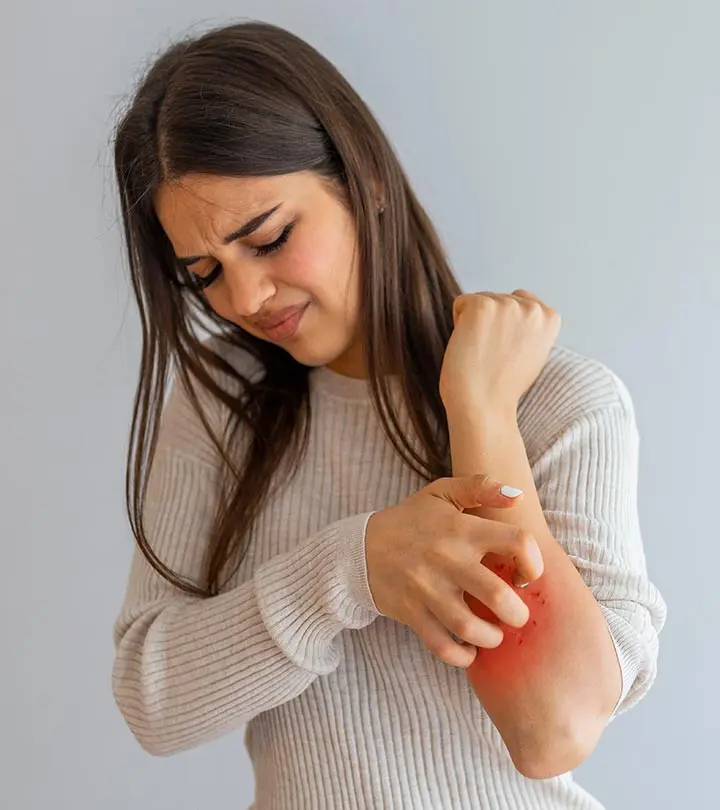





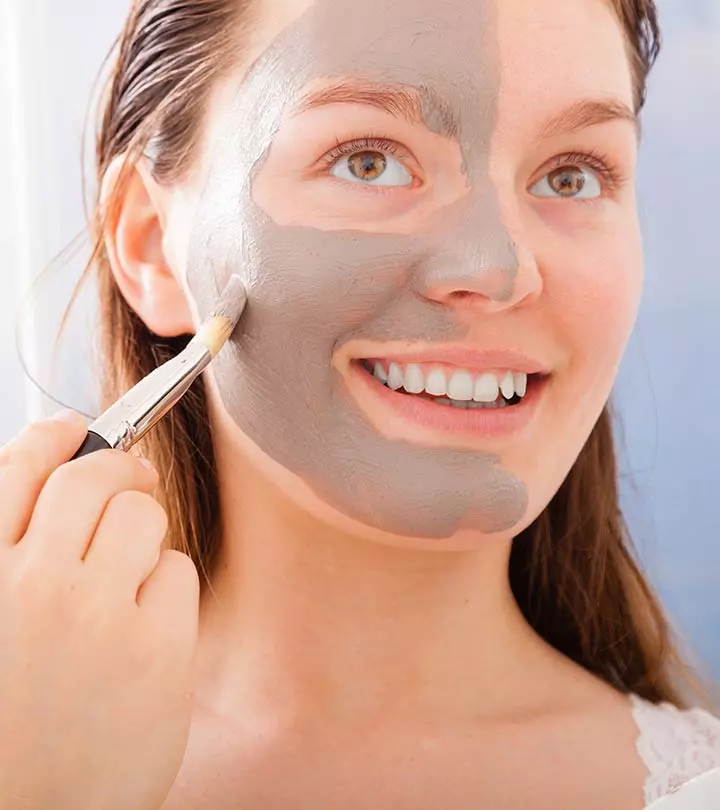



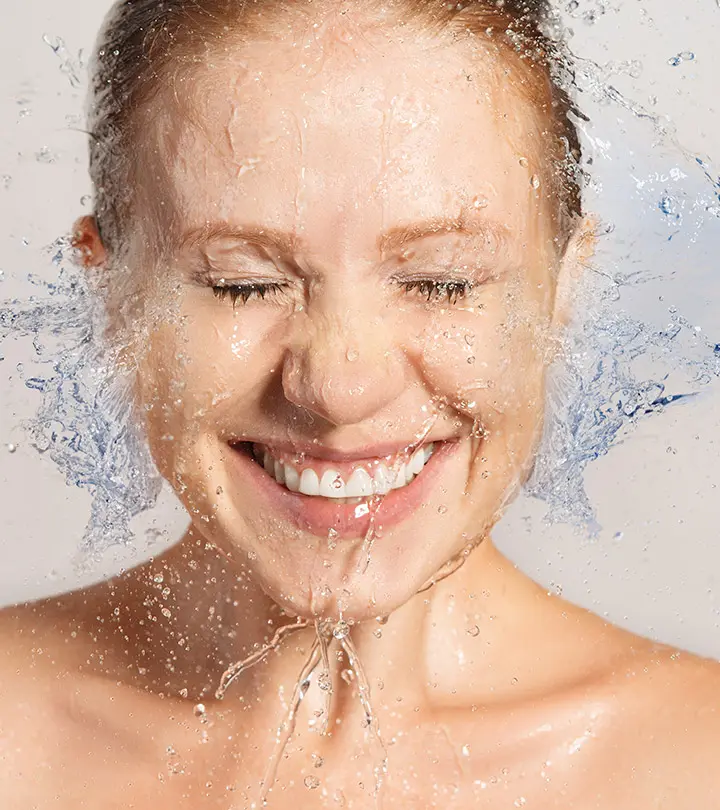
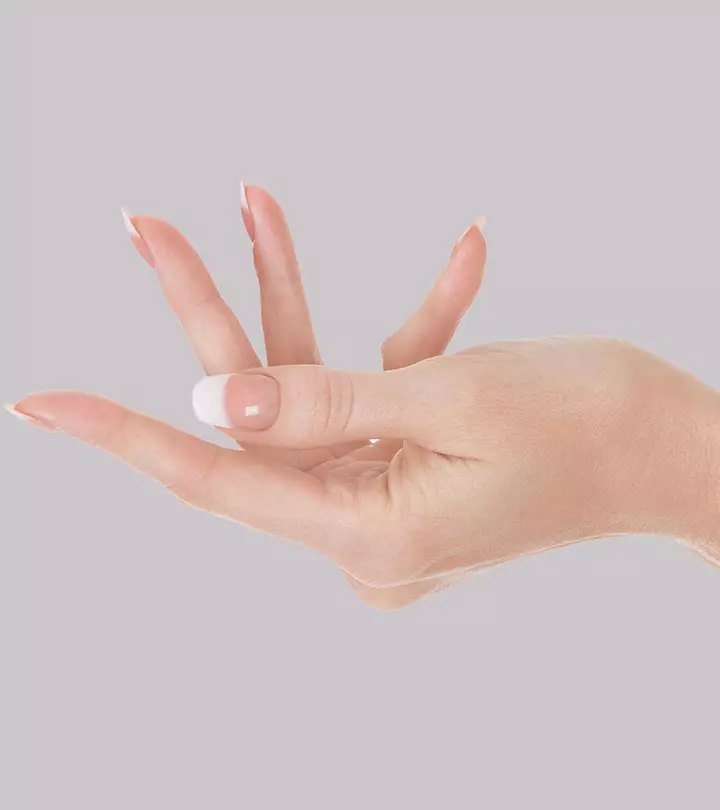
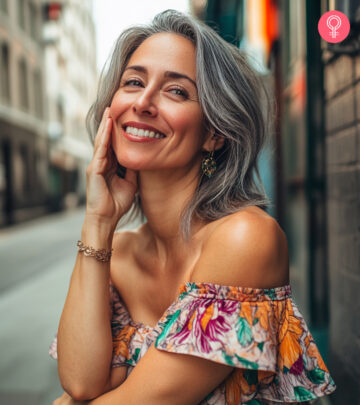
Community Experiences
Join the conversation and become a part of our empowering community! Share your stories, experiences, and insights to connect with other beauty, lifestyle, and health enthusiasts.